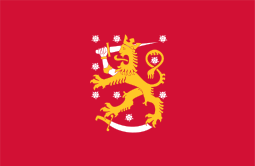You can help expand this article with text translated from the corresponding article in Finnish. Click for important translation instructions.
|
 | |
| State flag of Finland during the Civil War | |
| Use | State flag and ensign |
|---|---|
| Proportion | 17:26 |
| Adopted | 27 February 1918 |
| Relinquished | 29 May 1918 |
| Design | Rectangular Coat of Arms of Finland (colours gold and silver on red) |
White Finland, usually shortened to Whites (Finnish: Valkoiset, IPA: [ˈʋɑlkoi̯set]; Swedish: De vita, Swedish pronunciation: [de ˈviːta]), were the refugee and provisional government following the October Revolution and those forces who fought for and under Pehr Evind Svinhufvud's first senate, in opposition to the "Reds", the Finnish Socialist Workers' Republic, during the Finnish Civil War in 1918.
Background

White Finland was established as a provisional government on November 27, 1917 following the October Revolution, leading to the total collapse of the Personal Union between Finland and the Russian Republic. Following the establishment of the Soviet Russia, and with the recognition of Vladimir Lenin and other prominent Bolshevik officials in Russia, Finland was officially granted independence.
This Government was ruled from Vaasa from 29. January – 3. May 1918, and the Senate was moved there, as Helsinki had been captured by the Reds.
The Whites had no clear political aims in common, other than stopping the communist revolutionary Reds from taking power and returning to constitutional rule by a Senate (the government of the Grand Duchy of Finland) which was formed by the non-socialist parties of the Eduskunta (parliament) and returning to the Rule of Law. The provisional head of state of White Finland was Pehr Evind Svinhufvud, chairman of the senate at the time, and its military was commanded by Carl Gustaf Emil Mannerheim. The Conservative Senate government was supported by the remnants of the Finnish Legion stationed along the eastern front.

The main fighting force of the 'White Army' was the Protection Corps, which was a volunteer army mostly made up of the rural peasant and lower classes, as they made up around 77% of the entire protection corps fighting units. The Protection Corps had around 15,000 men in their ranks, and with conscription enforced, the numbers of the 'White Army' rose to around 60,000 men in total, with the conscription numbers, the working class become to consist of around 25% of the frontline troops.
The Jägers were recruited by Imperial Germany between 1914 and 1917 for military training, even participating alongside their German benefactors, in combat against the Russian forces on the Eastern Front, before returning to Finland for the upcoming civil war. Because Russia did not draft Finns for combat duties, their experience as First World War veterans had significant impact during the war. They received arms and equipment matching those of regular German troops, and sporadic further military support from the German Empire.
The White Army did not only just consist of Finnish men, however they also gained the support of foreign groups and voluntary military organizations, such as the 'Friends of Finland' group in Sweden, which organized and equipped Swedish volunteers to fight in Finland, this came with Swedish officers such as Ernst Linder, who came to command the Satakunta Group [fi]. The Whites also found sympathy from the Poles and Estonians, who also served as volunteers in combat.
Campaign
The Whites' campaign was initially challenged by the goal of capturing the Varkaus industrial center. The around 1,200 Red guardsmen who were controlling the city finally surrendered after the White troops secured the surrounding areas. This battle was one of the turning points of the civil war since it gave the Whites control of the northern part of Finland. The success of the campaign is attributed to the White's better equipment, organization, and unity.
By February 1917, Finland was already divided with the Whites controlling the area north of Pori, Tampere, Lahti, Lappeenranta, and Viipuri while the urban areas to the south were under the Red zone. With the assistance of the Germans under General Rüdiger von der Goltz, the Whites were able to capture Helsinki and Tampere until the Reds finally fled to Soviet Russia in April, and the victors inherited the borders of the former Grand Duchy. The initial frontlines were established rather quickly, and over the course of the war, Whites reclaimed all Finnish territory. The Finnish constitution of 1919 established the modern Republic of Finland, and the Treaty of Tartu between Finland and Russia (1920) confirmed the outcome. Thus, the Republic of Finland is the sole successor of White Finland.
References
- "1. Svinhufvud". Valtioneuvosto (in Finnish). Retrieved 2024-06-20.
- ^ The Finnish Civil War 1918: History, Memory, Legacy. BRILL. 2014-08-14. ISBN 978-90-04-28071-7.
- "Vaasan lyseon lukion vaiheita". Vaasa (in Finnish). Retrieved 2023-12-10.
- Unterseher, Lutz (2009). Military Intervention and Common Sense: Focus on Land Forces. Berlin: Ryckschau. pp. 20–21. ISBN 9783000280764.
- Pylkkänen, Ali (2001). Suojeluskuntalaiset - keitä he olivat?: vapaaehtoisten maanpuolustajien sosiaalinen kerrostuneisuus 1917-1944 (in Finnish). Maanpuolustuskorkeakoulu, sotahistorian laitos. ISBN 978-951-25-1256-0.
- Ylikangas, Heikki (2019-10-09). Tie Tampereelle (in Finnish). Werner Söderström Ltd. ISBN 978-951-0-43696-7.
- "Memorial to Finnish Jaegers in Klapkalnciems".
- Hannula, J. O. (1938). Suomen vapaussodan historia (in Finnish). WSOY.
- "Valtioneuvoston kanslia" (PDF). Archived from the original (PDF) on 2014-02-24. Retrieved 2023-12-10.
- ^ Tepora, Tuomas; Roselius, Aapo (2014). The Finnish Civil War 1918: History, Memory, Legacy. Leiden: Brill. p. 100. ISBN 9789004243668.
- ^ Singleton, Fred; Upton, Anthony F. (1998). A Short History of Finland. Cambridge, UK: Cambridge University Press. pp. 109, 110. ISBN 0521640695.